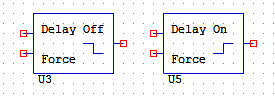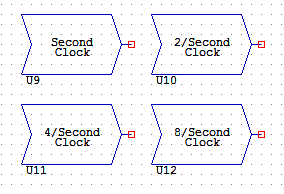Timers Objects
DELAYOFF/DELAYON
DELAYOFF object takes a single digital input and delays it from becoming false on its output. The timer value can be set in the Object Properties window. When the input goes from true to false, the timer starts. When the specified time expires, the output goes false. When the input goes from false to true, the output immediately goes true.
DELAYON takes a single digital input and delays it from becoming true on its output. The timer value can be set in the Object Properties window. The timer will start when the input goes from false to true. When the specified time expires, the output goes true. When the input goes from true to false, the output immediately goes false.
DELAYOFFFORCE/DELAYONFORCE
DELAYOFFFORCE is the same as a DELAYOFF, but with an additional input allowing the output to be forced to false without waiting for the timer to expire.
DELAYONFORCE is the same as a DELAYON, but with an additional input allowing the output to be forced to true without waiting for the timer to expire.
FASTCLOCK
FASTCLOCK toggles state every E-Plex clock cycle. The FASTCLOCK object will always provide the fastest possible clock speed for a system. The actual speed of the FASTCLOCK depends on the length of the E-Plex stream cycle. Smaller systems will run at more cycles per second, so will get more FASTCLOCK ticks per second.
ONESHOT
ONESHOT takes a single digital input and creates a single pulse on a single digital output when the input goes true. It's also edge triggered, meaning the pulse is created only when the input goes from false to true. The output will remain true for a single E-Plex stream cycle. There is no timer value to set on a ONESHOT object.
PULSEON
PULSEON takes a single digital input and pulses a single digital output on when the input goes true. It is edge triggered, meaning the pulse is created only when the input goes from false to true. The output will remain true for the entire length of the pulse as specified in the Object Properties window. Any edges detected in the middle of a pulse are ignored.






